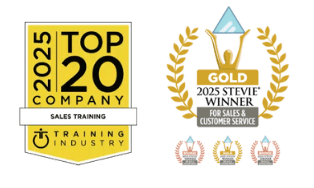There is a major issue within Sales and Marketing that, if corrected, will pay immediate dividends.
Too many of our salespeople are working too low in their client’s organization. They are limiting their upward mobility with their talk track. As sales leaders, we have the ability to transform our team’s performance by helping them use the right words, focused on creating client outcomes.
Most Sales and Marketing people are very knowledgeable about their product, service, or solution… but fall short when communicating their company’s value to client executives higher up in the organization. Senior client contacts are NOT interested in the details of your products or services, they are interested in the specific outcomes you achieve.
Unfortunately, most organizations haven’t done a good job of developing staff with strong business acumen and results-based outcomes. This sounds simple, but it takes dedicated communication training.
When our people talk with senior level contacts about our products or services instead of client outcomes, the client hears, “Wonka, Wonka, Wonka.” What is being said means nothing to them. They lose interest and they refer the salesperson back down to lower-level contacts, if at all.
Before asking staff to make sales calls with higher-level contacts, we need to invest in them to do it well. If people are creative, intelligent, and persistent, they will be able to gain a higher-level audience. That is where the problem lies. They have the audience, but they use the wrong talk track. They need to grab the client’s attention with insightful Thought Leadership or interest will fade—fast. What’s worse is the client also brands the Sales or Marketing person as lower-level… because they only seem capable of “Wonka” talk. If our people can’t use the right words with different levels of the organization, then they are limiting where they can go in the client’s organization. You don’t get a second chance to make a great first impression!
We need to recognize that providing more product, service, or solution training is not the answer – this is about communication training. Working on creative means of gaining access to key decision makers is also a poor choice, UNLESS our people can be comfortable talking to them about how they can affect the client’s business. Anything else is a reinforcement of “Wonka” talk.
Need proof? Read through some recent proposals. Review company presentations. Reflect on what level of the buyer’s organization is it truly targeted to. You’ll find that most sales communications are heavily focused on themselves – features, capabilities, awards won, and maybe even valued pricing. Rarely does supporting sales material focus on the desired client business outcomes and our realistic impacts.
As sales leaders, we need to help our people elevate their skills. Our team meetings should include time to discuss what we are uncovering as clients’ needs. That also means reducing the use of:
- Standardized proposals as solution-based templates. While proposals often have an executive summary, too much of the content is about the company and the solution. There is a heavy emphasis around capability, rather than what the client can achieve with your solution. It becomes another “Wonka” document. Look at what was written and help them translate it into client outcomes, such as revenue, margins, market share, savings, and reinvestment. This will help salespeople bridge into a much more successful conversation with higher-level decisions makers.
- Presentations a mile long. We often see sales presentations with 40 to 50 slides. Look for “Wonka” talk, and it will be the majority. The first 4 to 5 slides are typically about the seller! Countless sales presentation use this format and it needs to end… NOW! Instead, executive sales presentations should be limited to 7 to 10 slides. We recommend using Revenue Storm’s 7-Slide DeckTM Template as a foundation. If they can’t get their point across in this number of slides, they really don’t have a clear, concise message. The presentation should get people talking in the meeting, not sitting back listening to the salesperson. It should include thought provoking points and address how the client’s business could be improved, with specific outcomes. If they can quantify the outcomes with a range of potential impact… all the better.
- Key relationships in the client’s organization but at lower levels. Start to ask questions about specifically who your people have relationships with. Salespeople that speak “Wonka,” not surprisingly, have developed good relationships with people that also speak “Wonka.” Yet, will that lead to the revenue results and growth that you are seeking? Probably not!
How many people on your sales team are speaking “Wonka?” Let’s focus on immediately changing that. Provide them with targeted training and coaching to be comfortable focusing on client outcomes. Be sure to examine how much of this is institutional as well. Help your team by looking at the proposal templates and presentations for improvements. Fixes there can multiply across the sales team. With communication training, you can help them plan and practice conversations as well as expand higher-level relationships, leveraging the Encounter PlanTM Template for higher-level roles. If you get a few successes focused on client outcomes and impact, you can leverage that within your team.
Personal Challenge:
Start reviewing Account Relationship BarometerTM Tools and determine, by person, who is overly dependent on lower-level contacts. Ask each salesperson in their one-on-one meeting to come prepared to share what the client desired outcomes were for the last two sales and two of their current proposals. Listen to their words. Is it “Wonka” talk? For one of the situations, recommend how they could elevate the discussion with other messages targeted for higher-level people. Challenge them to identify what client business outcomes those people would want and ask them to validate those ideas with their Partner Allies or Supporters. Make a decision to elevate your team and start today with communication training.




